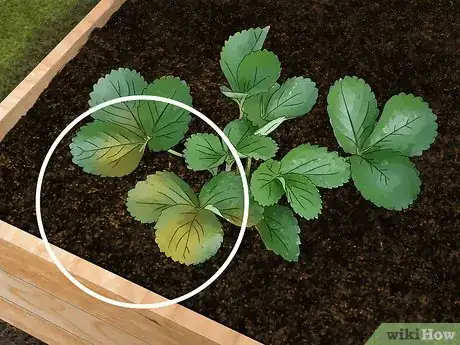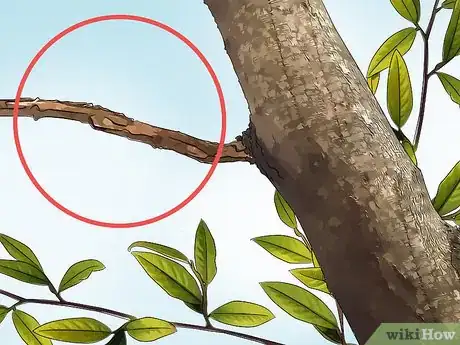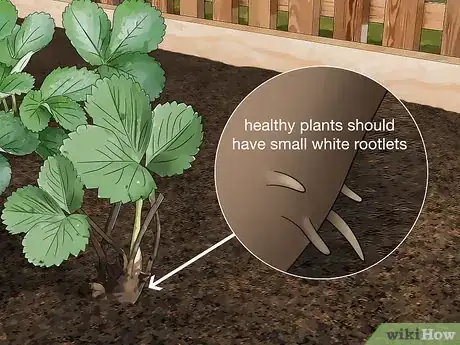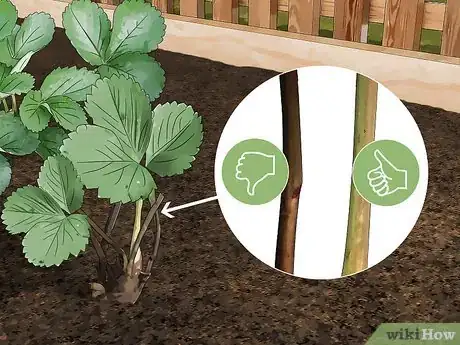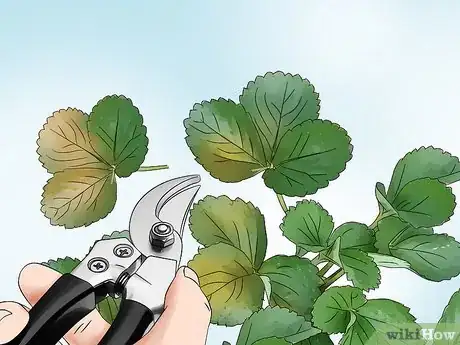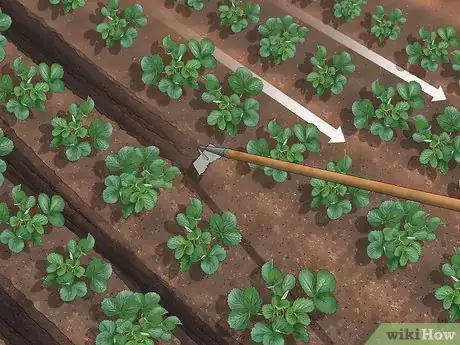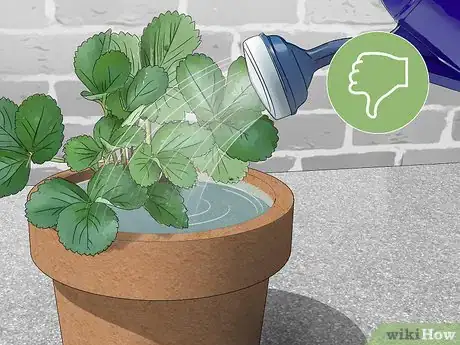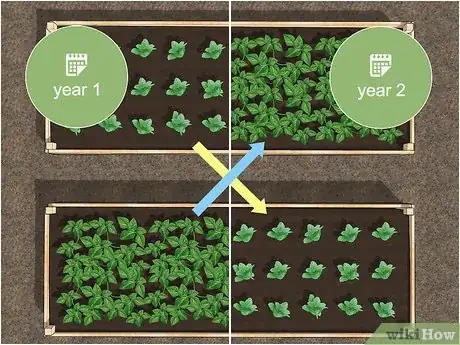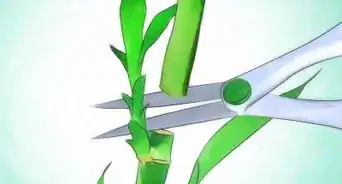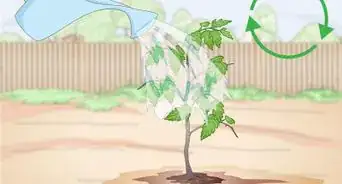This article was co-authored by Chai Saechao. Chai Saechao is the Founder and Owner of Plant Therapy, an indoor-plant store founded in 2018 based in San Francisco, California. As a self-described plant doctor, he believes in the therapeutic power of plants, hoping to keep sharing his love of plants with anyone willing to listen and learn.
There are 21 references cited in this article, which can be found at the bottom of the page.
This article has been viewed 77,924 times.
Root rot can be caused by a variety of different fungi, and it can affect trees, shrubs, and plants. Typically, one of the main triggers is over-watering, leading to too much moisture around the roots of the plant. This creates an ideal environment for the fungus to thrive. Check for symptoms to curtail the problem early, as it is difficult to treat. One of the main ways to treat it is to remove the affected plants and aerate the soil as best as you can. However, the best way to deal with root rot is to prevent it in the first place.
Steps
Watching for Root Rot
-
1Look for yellow leaves. One of the first signs of root rot is when the leaves begin to turn yellow or brown. That means they're not getting enough water and nutrients, which in turn is due to dying or damaged root systems.[1]
- The leaves may look dull first. When they turn yellow, they may also begin to wilt.[2]
- Yellow leaves can also be a sign of underwatering, though typically they'll curl and droop if it needs water. Plus, the soil will be dry.
-
2Watch for twigs and branches dying off in trees. If the root rot is severe, branches may begin to die off. In that case, they'll lose their leaves, and you'll see dry, brittle wood instead of supple branches and twigs.[3]
- Disease, drought, and crowding can also cause branches to die off.
Advertisement -
3Check for the absence of white feeder rootlets in plants. In healthy plants, you should see small white rootlets near the top of the soil at the base of the plant, which are starting to burrow down into the soil. If you can't see these, you likely have root rot.[4]
- You may want to gently dig up a plant you think is affected. The roots will be brown and mushy if they have root rot.
-
4Notice brown discoloring on the stems of plants. This discoloring can start out as streaks, then progress to spots or even turn the whole stem brown. Generally, it will start out near the base of the plant and work its way up.[5]
- In trees, you may see this under the bark near the base of the plant. Sometimes, the fungus will form inverted "Vs." Other times, it may move to the exterior of the bark, discoloring it or causing it to weep liquid.[6]
Fixing Root Rot in Indoor Plants
-
1Lift the plant up to look at the roots. Grab the plant at the base and pull it gently out of the pot. Gently brush away the dirt so you can look at the roots. They should be white and firm if they are healthy. If you see brown, mushy roots, you need to treat them for root rot.[7]
- You'll also be able to see other signs of root rot, such as brown stems and leaves.[8]
- If the roots look healthy, put it back in its pot and cover the roots back up with soil.
-
2Cut off the dying roots on partially healthy plants. Snip the roots off right where they turn healthy and toss the brown parts into the compost pile. Cut off all the dead roots you can see, as any left could infect the healthy roots that are left.[9]
- Keep track of what percentage of the roots you're cutting off. Just estimate; it's not a science!
-
3Snip off an equal part of the leaves and branches. When you cut back the roots, the roots that are left won't be able to support as much plant matter. Therefore, you need to trim the plant back. Start with any leaves that are yellow or brown, as well as any that look wilted. If you still need to trim more, prune the plant into a shape you like.[10]
- Make sure to leave some healthy leaves behind so your plant can still get the sunlight it needs.
-
4Put the plant into a clean pot and soil. If you want to use the same pot, dump the soil into the trash. Thoroughly clean out the pot with hot water and soap and then disinfect it. Put in clean, sterile potting soil and place the plant back into the soil.[11]
- To disinfect a pot, make a mixture of 1 part bleach to 9 parts water. Put the clean pot in the mixture to soak for 10 minutes (at least). Rinse out the bleach thoroughly when you're done.[12]
-
5Take away completely rotted plants. If the roots are rotted all the way through, you won't be able to save the plant. Take it out of the pot. If there are other plants in the pot, you can try to save them. Otherwise, trash the dirt and thoroughly clean out the pot before starting with fresh potting soil and new plants.[13]
- Make sure to scrub the pot down with soap and water and then disinfect it before using it again.
Dealing with Root Rot in an Outdoor Garden
-
1Apply nitrogen to help encourage plant and root growth. When plants succumb to root rot, they won't get enough nitrogen from the soil to thrive. Add between 20 and 50 pounds (9.1 and 22.7 kg) per 1 acre (4,000 m2). It's best to apply it between the rows, then cultivate between the rows to throw it up on the roots.[14]
- Opt for potassium nitrate, ammonium sulfate, or ammonium nitrate over urea.
-
2Cultivate between rows to help new root growth. If the roots underneath are rotting, sometimes new roots will grow near the surface. Cultivating or "scuffling" involves pulling cultivation teeth in the dirt between rows as a way of killing off weeds; in this case, it also tosses soil onto new root growth to help it thrive.[15]
- Make sure not to get too close to the plants, as that will slice off the ends of roots, which is the opposite of what you want to do. Go down the middle of the row to avoid the roots.
- Sometimes, it helps to do this twice in a row with about 5-10 days in between.
-
3Remove soil around the base of plants. Avoid putting plants in the ground deeper in the soil than how they came from the store. If you did, gently remove the soil from the base of the plant, but don't take out so much that the roots show.[16]
- This will help the roots near the top dry out and hopefully recover from root rot.
-
4Expose the root flare in trees if it's been covered in soil. The root flare is the point at the base of the tree where the roots begin to come out for support. If this has been covered up, your tree is more likely to get root rot. Use a shovel to uncover this area, exposing the main roots at the base of the tree.[17]
- Be careful when removing the soil, as you don't want to damage the roots.
-
5Water trees and shrubs away from the base of the plant. Root rot tends to occur right near the crown of the plant where the roots begin to flare. To keep from making the problem worse, don't water at this point. Instead, water around shrubs and trees, so that they still have access to water but don't hold moisture near the crown.[18]
-
6Avoid using fungicides on roots. While it seems logical to try to treat a fungus-based problem with fungicide, they're usually not effective for this issue. For one, it's hard to get the fungicide to the root of the plant. Also, once a plant has root rot, they won't bring the plant back to life.[19]
- It's best to just avoid the chemicals and start over next year if you need to.
-
7Remove the affected plants so it doesn't spread. If the root rot is particularly bad, you may just need to take out the plants. If the leaves and stems are completely withered and dead, those plants are not coming back, and you need to think of the other plants around them. Pull these plants up, and then place compost where the hole is to help combat the fungus.[20]
- Make sure to toss these plants in the trash so they can't infect other ones.
-
8Sow plants resistant to root rot in the beds in the future. The fungi that cause root rot can stick around in the soil, so if you want to sow the bed again, opt for plants that are less likely to catch it. While that won't guarantee a root rot-free bed, it can help prevent another outbreak.[21]
- For instance, try plants like lilies, mints, ornamental grasses, daffodils, anemone, or black-eyed Susans, just to name a few.
Preventing Root Rot
-
1Avoid over-watering plants in gardens and pots. Over-watering is one of the main triggers of root rot since it leads to moist soil that can't drain well. While you can't prevent heavy rains, you can research your plants to figure out what amount of water they need and only give them enough to fulfill their needs.[22]
- This is especially an issue if you have a heavy soil type, such as clay.
-
2Put in raised beds for better drainage with outdoor plants. Plants susceptible to root rot, such as parsley, do well in raised beds. Moisture is less likely to sit around the roots because you can put in well-draining soil. Plus, the beds will lose more moisture to the air if they are surrounded by a porous material like wood.[23]
- You can find kits to make raised beds online, but you can also make your own out of planks of wood, bricks, or any number of other materials. You can even use things like old wine crates for a garden bed.
-
3Add organic material like pine bark to garden or potting soil to encourage drainage. If you don't want to use raised beds, you can encourage better drainage by tilling material into your soil.[24] Use compost, manure, shredded leaves, or grass clippings, for instance, which will make your soil lighter. Put a layer of 2 to 3 inches (5.1 to 7.6 cm) on top of your soil and then work it in to about a depth of 6 to 8 inches (15 to 20 cm).[25]
- You'll need to work this material in throughout the year, as microorganisms will continue to compost it.[26]
-
4Try core aeration to encourage better drainage in outdoor plants. Dig up holes that are 1 to 2 inches (2.5 to 5.1 cm) wide in the ground, going to a depth of about 1.5 feet (0.46 m). Aim for a hole every 1–2 feet (0.30–0.61 m). Fill the holes with a mixture of peat moss and pumice/baked clay in equal parts.[27]
- Core aeration is where you pull out small plugs of soil and replace them with an inorganic material. The process helps create lighter soil.
- You may need an aeration tool for this process. To use one, just press the hollow points of the tool into the ground, and it will pull out small plugs of soil for you.
-
5Rotate out vegetables that are susceptible to root rot. If you know certain plants in your garden are more likely to get root rot, change up where you plant them each year. For instance, parsley and some beans are susceptible, so don't put them in the same place when you plant in the spring.[28]
- For resistant plants, try geraniums, marigolds, sweet potato vine, ferns, aster, mint, or ornamental grasses.
- Try to rotate the plants out every year.
-
6Put outdoor plants and trees with similar watering and fertilization needs together. If you have plants that like a lot of water in an area with plants that prefer drier soil, the drier soil plants are more likely to develop root rot. If you put similar plants together, you can give them what they need without worrying about over-watering some of them.[29]
Expert Q&A
Did you know you can get expert answers for this article?
Unlock expert answers by supporting wikiHow
-
QuestionShould I prune the roots if they start sticking out of the soil?
 Chai SaechaoChai Saechao is the Founder and Owner of Plant Therapy, an indoor-plant store founded in 2018 based in San Francisco, California. As a self-described plant doctor, he believes in the therapeutic power of plants, hoping to keep sharing his love of plants with anyone willing to listen and learn.
Chai SaechaoChai Saechao is the Founder and Owner of Plant Therapy, an indoor-plant store founded in 2018 based in San Francisco, California. As a self-described plant doctor, he believes in the therapeutic power of plants, hoping to keep sharing his love of plants with anyone willing to listen and learn.
Plant Specialist It's generally a bad idea to clip the roots off since they're so sensitive. If you do this, you may end up accidentally killing the plant. If the roots are sticking out, it's usually a sign that you need to transplant your plant to a bigger pot. So take whatever your current pot's size is and move up two additional sizes.
It's generally a bad idea to clip the roots off since they're so sensitive. If you do this, you may end up accidentally killing the plant. If the roots are sticking out, it's usually a sign that you need to transplant your plant to a bigger pot. So take whatever your current pot's size is and move up two additional sizes.
References
- ↑ https://www.rhs.org.uk/advice/profile?pid=542
- ↑ https://www.veggiegardener.com/threads/root-rot.2117/
- ↑ https://www.rhs.org.uk/advice/profile?pid=542
- ↑ https://www.veggiegardener.com/threads/root-rot.2117/
- ↑ https://www.veggiegardener.com/threads/root-rot.2117/
- ↑ https://www.rhs.org.uk/advice/profile?pid=542
- ↑ https://www.theguardian.com/lifeandstyle/2017/nov/12/how-to-rescue-your-houseplants-from-overwatering
- ↑ https://extension.psu.edu/preventing-diagnosing-and-correcting-common-houseplant-problems
- ↑ https://www.theguardian.com/lifeandstyle/2017/nov/12/how-to-rescue-your-houseplants-from-overwatering
- ↑ https://www.theguardian.com/lifeandstyle/2017/nov/12/how-to-rescue-your-houseplants-from-overwatering
- ↑ https://www.theguardian.com/lifeandstyle/2017/nov/12/how-to-rescue-your-houseplants-from-overwatering
- ↑ https://hortnews.extension.iastate.edu/1994/3-16-1994/clean.html
- ↑ https://extension.psu.edu/preventing-diagnosing-and-correcting-common-houseplant-problems
- ↑ https://fieldcropnews.com/2014/07/root-rot-in-edible-beans-no-easy-fix/
- ↑ https://fieldcropnews.com/2014/07/root-rot-in-edible-beans-no-easy-fix/
- ↑ https://www.veggiegardener.com/threads/root-rot.2117/
- ↑ https://www.missouribotanicalgarden.org/gardens-gardening/your-garden/help-for-the-home-gardener/advice-tips-resources/pests-and-problems/diseases/rot/phytophthora-root-rot-of-trees-and-shrubs.aspx
- ↑ https://www.veggiegardener.com/threads/root-rot.2117/
- ↑ https://www.veggiegardener.com/threads/root-rot.2117/
- ↑ https://www.growveg.com/plant-diseases/us-and-canada/parsley-root-rot/
- ↑ https://static1.squarespace.com/static/50db5688e4b00220dc71db15/t/5176d8efe4b0c6cbe9570392/1366743279673/Info+Sheet_Phytophthora+Resistant+Plants.pdf
- ↑ http://www.plantsgalore.com/care/disease/Diseases-root-rot-phytophthora.htm
- ↑ https://www.growveg.com/plant-diseases/us-and-canada/parsley-root-rot/
- ↑ https://www.missouribotanicalgarden.org/gardens-gardening/your-garden/help-for-the-home-gardener/advice-tips-resources/pests-and-problems/diseases/rot/phytophthora-root-rot-of-trees-and-shrubs.aspx
- ↑ https://garden.org/learn/articles/view/1310/
- ↑ https://static1.squarespace.com/static/50db5688e4b00220dc71db15/t/5176d8efe4b0c6cbe9570392/1366743279673/Info+Sheet_Phytophthora+Resistant+Plants.pdf
- ↑ https://www.veggiegardener.com/threads/root-rot.2117/
- ↑ https://www.growveg.com/plant-diseases/us-and-canada/parsley-root-rot/
- ↑ https://www.missouribotanicalgarden.org/gardens-gardening/your-garden/help-for-the-home-gardener/advice-tips-resources/pests-and-problems/diseases/rot/phytophthora-root-rot-of-trees-and-shrubs.aspx
